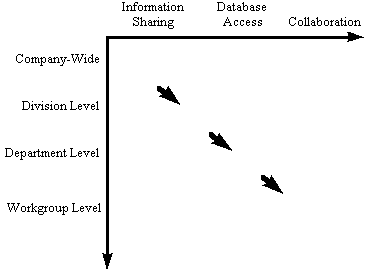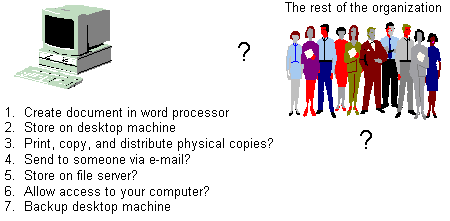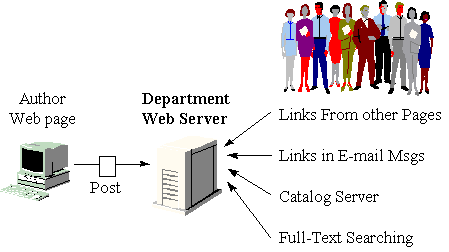The intranet is rapidly evolving beyond company-wide information sharing. Companies are starting to use a new breed of personal web-authoring tools to share information at the workgroup level. The result is a significant gain in efficiency compared to traditional ways of sharing team information. This paper for IS managers and department managers describes how to share information at the workgroup level, which applications to consider, and what the benefits are.
The Evolution of the Intranet
Sharing Information Today
The New Way of Sharing Information
The Applications
An Application Example
The Tools
Summary
By all accounts the Internet is a tremendous phenomenon that promises to transform the computer industry in many ways. Hoards of companies are racing to build intranets to take advantage of Internet technologies inside their companies. By deploying intranets, companies are able to distribute internal information to employees far more cost effectively than by other means, such as mailing printed materials. Information is always current and accessible from any platform.
The focus of intranets to date has been to distribute companywide information such as company news, corporate policies, employee information, internal job postings, bulletin boards, phone directories, press releases, and computing policies. The results have been dramatic. For example, General Electric is saving $240,000 a year in printing costs by using its intranet to publish a simple directory of company information. Results have been equally dramatic for implementation costs. Eli Lilly has linked some 3000 employees on an intranet for a total cost of just $80,000.
With some experience under their belts and as second-generation products are being announced, companies are starting to realize the full potential of intranets. If an Internet client provides a simple interface for accessing the Internet and general company information, why not extend to other types of company information and applications, such as those stored on databases? Then take another step and extend down to department- and workgroup-level information sharing. Figure 1 shows this anticipated progression.

Figure 1. The evolution of intranets.
Many independent analysts and reporters have described this evolution in recent months.
"File service will jump to the Web. Today users are able to view
only HTML files that first must be posted by the Webmaster. Over the next
two years, the Web's underlying HTTP standard will be beefed up to permit
authenticated users to check out, edit, and repost files of any format
- including word processing, spreadsheet, and graphic documents - to a
Web server. FTP, Netscape, and O'Reilly are already taking first stabs
at this."
Forrester: "The Full Service Intranet"
"As intranet products gain critical features - a process that should
take about 18 months - they will be legitimate replacements for products
like NetWare, Notes, and Exchange."
Burton Group: "Netscape Gets Serious About Infrastructure"
"For a taste of the future, check out Silicon Graphics. The maker
of high-end graphics workstations began using the Web internally almost
as soon as Mosaic, the original Web browser, was born. The company started
out with the basics - publishing information electronically and making
it available to employees at the company's Mountain View (Calif.) headquarters
and around the world. Today [says Frank Dietrich, SGI corporate web systems
manager], 'There's barely a piece of information that's not online.'"
Business Week: "Here Comes the Intranet"
"By the year 2000, intranet servers will outsell Internet servers
4.6 million to 440,000."
IDC Forecast, March 1996
While there are good reasons for companies to start their intranet deployments by publishing companywide information, that's only the tip of the iceberg. Most information that exists in an organization is specific to a department or workgroup, where people are busy as part of many different teams trying to complete projects and achieve objectives. Web publishing at the department or workgroup level can yield perhaps even greater benefits by boosting information sharing, collaboration, and ultimately workgroup productivity. The rest of this paper explains how.
Before you try to understand the benefits of sharing information with
intranet tools, it helps to step back and think about how most companies
try to share information today. The typical organization sets up users
with:
Some organizations have taken an additional step by deploying a document management system or a groupware system such as Lotus Notes. While Lotus Notes has received a lot of attention, only a small fraction of networked office computers have a groupware system installed1. Most companies continue to depend heavily on the tools listed above.
None of these tools were fundamentally designed for easy information sharing across an enterprise. Word processors were designed to create great-looking printed documents, not to share documents electronically. File servers were designed to provide shared access to files and applications in a workgroup. They focused on fast, reliable, controlled access to shared files rather than on helping users actually find the information on them. Email was designed to send short messages to one or more people. It wasn't intended to distribute shared information or to enable group communications.
Figure 2 illustrates the frustration with today's tools.

Figure 2. Sharing workgroup information the old way.
FILE SERVERS
As the workhorses of the old way of sharing information, file servers
are great at providing fast, reliable, controlled access to shared files.
They are terrible at helping users find information. Traversing directories
of files with eight-character names just doesn't work. Even if a user finds
the right information on a file server, he or she may not have the required
application to view or edit it.
PEER-TO-PEER NETWORKING
Using a workgroup network operating system (NOS) like Windows for Workgroups
or Windows 95 lets users give others access to their own hard drive. This
is convenient, but is useful only when someone knows there is a file on
your machine that they need. The only way they could find out is by word
of mouth or by searching everyone's personal drive. Using this technology
as a basic way to share information can be summed up in one word: chaos.
EMAIL
Email has steadily become a more popular tool for sharing information
and keeping people in the loop. The advantage of email is that people have
developed reasonably good habits about checking their in-boxes on a regular
basis. The downsides of using email for information sharing are significant.
For example:
PRINT, COPY, AND DISTRIBUTE
This old-fashioned way of distributing information is still used in
most organizations. The disadvantages to this model are obvious. It requires
that people must:
All of this is time-intensive and inefficient. This model adds to desktop
clutter, is an insecure way of sharing confidential information, and gives
readers no way to access the information while traveling or working at
home.
DOCUMENT MANAGEMENT OR
GROUPWARE DATABASE
Storing documents in a groupware product that offers a shared database
for a specified set of members is a more sophisticated way of sharing information.
Documents are placed in a database that can be accessed by any of its members,
and these databases can be replicated to other servers and to laptop computers.
One of the biggest issues with this type of system is that they are generally
complicated to set up and maintain, especially when replication is involved.
A study by Workgroup Systems showed that the purchase price of Lotus Notes
was only 5 percent of the total three-year cost of ownership. The complexity
of these types of systems prevents them from being rolled out to an entire
company, let alone with partners outside the company. If a groupware system
is installed only in pockets of an organization, it obviously doesn't work
as a general information-sharing tool.
The other big problem with this approach is that groupware systems have been proprietary. They store documents in a proprietary format, use proprietary protocols, and generally lock companies into a single-vendor solution. Interoperability with other companies and partners is very challenging because these systems are not based on standards.
PUBLIC FOLDERS
Public folders are another recent addition to the list of information
sharing technologies. Microsoft had good intentions when it designed a
system (Microsoft Exchange) that would provide a similar email-like interface
for accessing private and public information. The problem is that navigating
through rich information with hypertext links is far simpler and more intuitive
than double-clicking on folder icons. The other issue with public folders
is that they provide a different user interface than the one used for accessing
the vast information on the Internet. It is much more seamless to access
internal and external information with an identical, easy-to-use interface.
The industry is undoubtedly ready to share internal information in a way that is faster, easier, and more efficient. Web technology has made it easier for users to navigate through massive amounts of information on the Internet and increasingly on intranets. It is natural to extend this information-access capability to include departmental- and workgroup-level information, where the most pertinent data exists. This can be accomplished by enabling web-page authoring for all users in an organization.
Using personal web-page authoring tools, users can share information like a new product proposal, a schedule for a project, a cost-reduction plan, quarterly objectives, and information on a competitor.
In this model, virtually all corporate information - from companywide information to workgroup and personal information - is stored on intranet web servers. What makes this model possible is a new breed of personal web-page authoring tools that make it as easy to publish information on an intranet web server as it is to save a word processor document on a local PC. Also, each document or directory of documents can have strict access control. An administrator can configure who can read and who can edit the documents.
Why is this a good model? Sharing all information on intranet web servers gives users access to all information, from their PC to a remote server in another country, with a single easy-to-use interface. For content creators it greatly simplifies the task of distributing information. An author can post information on one server, then have users find out about it through a variety of mechanisms, as illustrated in Figure 3.

Figure 3. Sharing workgroup information the new way.
HOW IT WORKS
The process of creating and maintaining information using personal
web-page authoring tools is straightforward. It involves the following
steps, which can be mastered easily by almost any user in a typical organization.
Assistance from a webmaster is unnecessary.
BENEFITS
The benefits of sharing information with Navigator Gold versus traditional
tools are significant. Gold offers the following five key benefits:
Personal web-page authoring is such a general purpose tool that it can be used for an almost unlimited number of applications. Any type of information that needs to be shared with others in the organization can be shared using a departmental web server. This applies to documents that are only a paragraph long as well as to ones that involve numerous linked pages. Following are some specific situations where documents can be shared using departmental web servers:
SHARING INFORMATION WITH
CROSS-FUNCTIONAL PROJECT
TEAMS
One of the most common situations is to have a cross-functional project
team that's working on the development of a new product or service. These
teams tend to be dispersed across different departments, possibly at different
locations, and are also often using different types of computers (PC, Mac,
or Unix). Personal web-page authoring is a perfect way for these teams
to share information. They can easily share documents like:
SHARING INFORMATION WITHIN
DEPARTMENTS
It can be critical to share information throughout departments. People
need to know what others in their department are doing and need to know
the best ways to accomplish tasks. With personal web-page authoring, employees
within departments can easily share things like:
SHARING INFORMATION ACROSS
SALES DEPARTMENTS AND HEADQUARTERS
One challenge that many companies face is to maintain good communications
between their sales forces, who are geographically distributed, and the
headquarters office. Sales representatives are constantly being pummeled
with questions and requests for more information or assistance. They also
receive daily feedback on why the company's products do or don't meet customers'.
Traditionally, it has been difficult to facilitate timely and accurate
information exchange between sales representatives and people at headquarters.
With personal web-page authoring, the following types of information can
be exchanged easily:
SHARING INFORMATION ABOUT
YOURSELF
Another big challenge, especially in larger organizations, is to become
familiar with all the people you need to work with who might be able to
help you do your job. By describing yourself, your position, your location,
and possibly including a photo, you can help other people in the organization
learn about you more quickly and easily.
One common type of document that needs to be shared companywide is a proposal. In this example, a marketing manager (Tom) at a fictitious company called Juggler Toys has used Navigator Gold to create a web page titled "New Product Ideas for Fall 1996." This document was created in minutes using Navigator Gold's easy WYSIWYG editor. It uses traditional word-processing capabilities such as rich text to highlight section titles, and also uses web-specific features such as embedding images, a separator, a background, and links. Images are included to show pictures of the products he's proposing, and links are included to easily jump to the proposed production schedule and specific sections of the document.
Once it has been created, Tom posts the proposal to the marketing web server in a directory that was set up for him. Then he sends the URL via email to the product review committee so they can easily review his proposal and jump to the associated schedule if desired.

Figure 4. An example of sharing product ideas.
To see a demonstration of how this document was created, check out the Navigator Gold demo.
NETSCAPE NAVIGATOR GOLD
Netscape Navigator Gold includes all of the features of Netscape Navigator
plus essential applications for intranet productivity. The first
and most obvious set of essential applications is for creating and sharing
intranet content.
In its current version, Gold includes applications for creating, editing, and publishing web pages, and it makes it easy for users to create internal web pages. Navigator Gold includes the following features:
ENTERPRISE AND FASTTRACK
SERVERS
Netscape Navigator Gold works in tandem with Netscape's second-generation
web servers. The Enterprise and FastTrack Servers not only include speedy
performance, reliability, security, and management but they also have robust
features for departmental information sharing, including:
CATALOG SERVER
Netscape Catalog Server provides an automated way to generate a "Yahoo"-style
directory for a company's intranet. This gives users the ability the easily
find information based on subject, in addition to full-text searching and
following links.
An agent installed with each web server monitors for new documents. When a new document is added to any web server, the agent informs the Catalog Server so the document can be cataloged and available under the associated subject.
We are on the cusp of a revolution in the way companies share internal information. Many have already begun setting up intranets, but have focused primarily on companywide information. As intranets evolve they will expand to include new types of applications like collaborative functions, and information sharing will extend down to departmental and workgroup levels. To enable information sharing at the workgroup level, a new breed of personal web-page authoring tools is arriving. Foremost among these is Netscape Navigator Gold, which builds personal web-page authoring right into the popular Netscape Navigator. Netscape Navigator Gold allows all users in an organization to participate in an intranet by contributing information that needs to be shared with teams. Netscape Navigator Gold works in tandem with the Netscape Enterprise Server and the Netscape Catalog Server to provide a complete information-sharing solution.
1 The Lotus Notes installed base is estimated to be about 4 million (spring 1996).
Corporate
Sales: 415/937-2555; Personal Sales: 415/937-3777; Federal Sales: 415/937-3678
If you have any questions, please visit Customer
Service.
Copyright © 1996 Netscape Communications Corporation